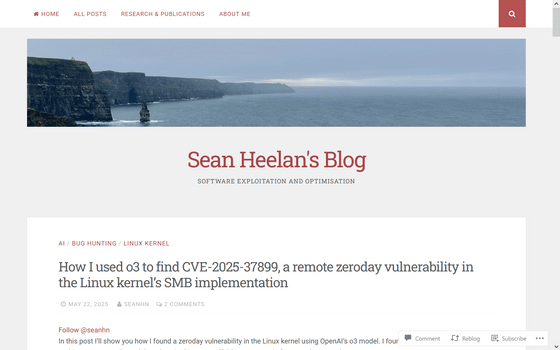How OpenAI’s o3 model uncovered a zero-day vulnerability in the Linux kernel

Technology expert Sean Heelan explained how he discovered a zero-day vulnerability in Linux using OpenAI's AI model '
How I used o3 to find CVE-2025-37899, a remote zeroday vulnerability in the Linux kernel's SMB implementation – Sean Heelan's Blog
https://sean.heelan.io/2025/05/22/how-i-used-o3-to-find-cve-2025-37899-a-remote-zeroday-vulnerability-in-the-linux-kernels-smb-implementation/

While investigating vulnerabilities in the Linux kernel server 'ksmbd,' which implements the SMB 3 protocol in kernel space to share files over a network, Heelan ran benchmark tests to measure o3's capabilities with bugs he found in ksmbd.
The vulnerability that Heelan used as an indicator was the vulnerability '
When verifying this vulnerability, all that is required is to check whether a process such as 'if a certain code is enabled, perform a certain process. If not, perform a different process' is working properly, but since it requires reading a minimum amount of code and inferring what process will be performed in a certain situation, Mr. Heelan thought that this would test the AI's reasoning capabilities.

So Heelan tasked o3 with looking for use-after-free vulnerabilities and asked them to provide a clear, high-level overview of what ksmbd is, what its architecture is, and what the threat poses.
As a result, o3 found vulnerabilities in 8 out of 100 runs. In a different model, Claude Sonnet 3.7 found vulnerabilities in 3 out of 100 runs, and Claude Sonnet 3.5 found vulnerabilities in 0 out of 100 runs.
Having tested o3's capabilities, they gave it more detailed prompts and tried again, and in one out of 100 tries it identified a previously unknown zero-day vulnerability and provided a detailed explanation of how to deal with it.
Heelan verified this and officially reported it as '

'O3's report shows that AI tools can be useful in vulnerability research. O3 has made great strides in its ability to reason about code. If you're an expert-level vulnerability researcher or exploit developer, O3 won't replace you, but it will make you a lot more efficient. There's a good chance that it will frustrate you with meaningless results, but it's also a good chance that it will get it right, so it's well worth using,' said Heelan.
Related Posts:







